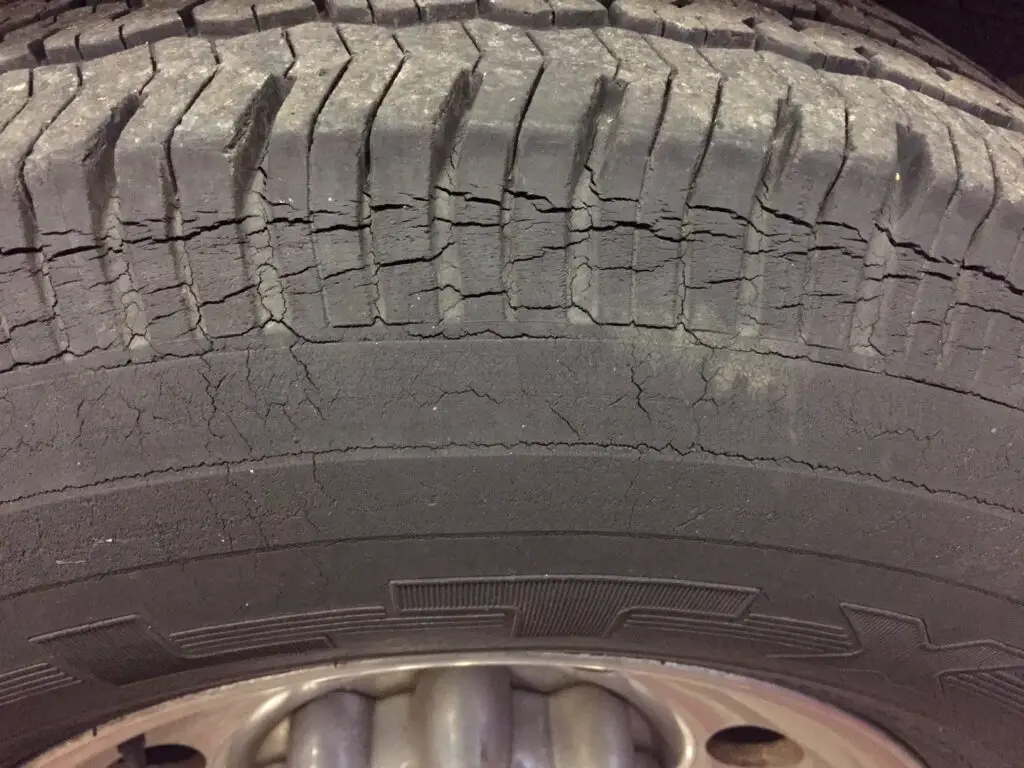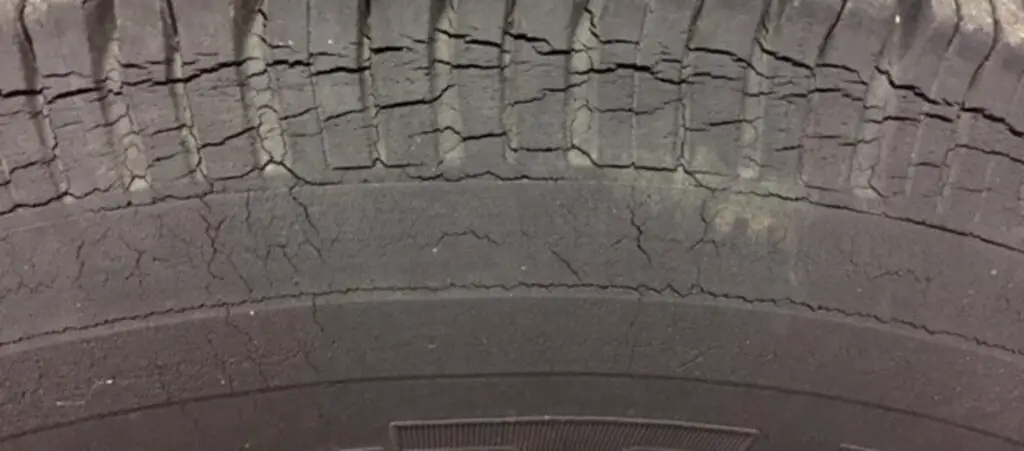Can you drive on dry rotted tires? No, driving on dry rotted tires is extremely dangerous. Dry rot weakens the tire’s structure, making it more prone to blowouts, poor traction, and loss of control, increasing the risk of accidents. It’s important to replace dry rotted tires immediately for the safety.
When it comes to vehicle safety, tires are one of the most important components. They are the only part of the vehicle that directly touches the road, and their condition directly impacts the vehicle’s performance and the safety. Over time, tires can deteriorate due to various factors, including age, exposure to the elements, and lack of proper maintenance. One of the most dangerous issues that can occur with old tires is dry rot.
Dry rotted tires are prone to failure and can cause catastrophic accidents if not replaced in time. In this article, we will explain the risks associated with driving on dry rotted tires, how to spot them, and why replacing them immediately is important to ensure the safety on driving time.

Contents
What Are Dry Rotted Tires?
Dry rot occurs when the rubber in the tires deteriorates due to age, environmental exposure, and lack of proper maintenance. When a tire is exposed to excessive heat, sunlight, and ozone, it starts to break down, causing the rubber to lose its elasticity. This process is known as “oxidation,” and over time, it leads to the formation of cracks in the tire. These cracks are the hallmark of dry rot.
Driving on dry rotted tires is risky because these tires are more prone to blowouts, loss of traction, and even sudden tire failure. This is particularly dangerous when driving at high speeds, in wet conditions, or while taking sharp turns.
Signs of Dry Rotted Tires
Before driving on dry rotted tires, it’s important to know how to identify them. Here are some common signs that the tires may have dry rot:
- Visible Cracks or Splits in the Rubber: The most obvious sign of dry rot is visible cracking or splitting on the surface of the tire. These cracks often appear along the sidewalls or tread of the tire.
- Brittle, Shiny, or Discolored Rubber: Tires affected by dry rot may look shiny or brittle, and the rubber may feel hard or dry to the touch. The color of the tire can also change, becoming darker or more yellowish.
- Tire Deformation: As the tire ages and the rubber loses its integrity, the tire may begin to bulge or develop uneven wear patterns. This can affect the handling and stability of the vehicle.
- Increased Vibration While Driving: If you notice an increase in vibration or wobbling while driving, it could be due to the weakened structure of dry rotted tires. The tires may not provide proper support, leading to unstable handling.

Can You Drive on Dry Rotted Tires?
The simple answer is: no, you should not drive on dry rotted tires. Here are several reasons why:
Increased Risk of Blowouts
Dry rotted tires are more prone to blowouts because the rubber has lost its strength and elasticity. As the tire’s internal structure weakens, the risk of sudden failure increases. Driving at high speeds or under heavy loads exacerbates this risk, as the tires are more likely to burst without warning.
Poor Traction and Handling
As dry rotted tires lose their flexibility, they struggle to grip the road properly. This can lead to poor traction, especially in wet or icy conditions, which could increase the likelihood of skidding or losing control of the vehicle. Dry rot also compromises the ability of the tire to effectively channel water away from the tread, which can lead to hydroplaning in rainy weather.
Reduced Stability
Tires that have dry rot are more likely to develop bulges, deformities, and uneven wear, all of which reduce the stability of the vehicle. This instability can make driving more difficult, especially when taking sharp turns or navigating rough roads.
Uneven Wear and Tear
Driving on dry rotted tires can cause uneven wear patterns, which further decreases their lifespan and makes them even more dangerous to drive on. You may notice that the tread on the tires is wearing down unevenly, which could result in a loss of control or difficulty stopping the vehicle.
Sudden Tire Failure
The most dangerous consequence of driving on dry rotted tires is sudden tire failure. When dry rot has severely compromised the tire, it can fail unexpectedly. This can happen while driving at high speeds, which is particularly hazardous, as it can cause a loss of control and lead to a serious accident.
The Risks of Ignoring Dry Rot
Ignoring the condition of the tires and continuing to drive on dry rotted tires can lead to serious consequences. Not only does it pose a safety risk to you and your passengers, but it can also lead to:
- Higher Repair Costs: Driving on compromised tires can cause damage to other parts of the vehicle, including the suspension system, alignment, and wheel rims. In the long run, replacing damaged tires can be much cheaper than ignoring the issue and dealing with the costs of further damage.
- Legal Consequences: In some regions, driving on tires that are deemed unsafe, including those with dry rot, may be illegal. If you are caught driving on tires that fail to meet safety standards, you could face fines or even have the vehicle impounded.
- Damage to the Environment: Tires that have reached the end of their lifespan contribute to environmental pollution. When tires deteriorate, the rubber particles can be released into the environment, causing harm to local ecosystems. It’s better for the planet to replace the tires when they are no longer safe.
How to Prevent Dry Rot in Tires
While dry rot is a natural process that occurs over time, there are steps you can take to extend the life of the tires and minimize the risk of dry rot:
- Store Tires Properly: If you have a spare set of tires or seasonal tires, store them in a cool, dry place away from direct sunlight. Ideally, tires should be stored indoors, away from heat sources and ozone-producing appliances.
- Regularly Inspect Tires: Check the tires regularly for signs of dry rot, such as cracks, discoloration, or bulges. Early detection can help prevent further damage and make replacement easier and cheaper.
- Avoid Overexposure to Sunlight: Prolonged exposure to the sun’s UV rays accelerates the process of dry rot. Whenever possible, park the vehicle in a shaded area or use tire covers to protect the rubber from UV rays.
- Keep Tires Properly Inflated: Underinflated tires are more likely to develop dry rot and wear out prematurely. Ensure the tires are inflated to the recommended tire pressure to keep them in optimal condition.
Frequently Asked Questions
Here are some FAQs about driving on dry rotted tires –
1. How long do tires last before they dry rot?
Tires generally last around 6 to 10 years, depending on factors like usage, climate, and maintenance. However, dry rot can begin to form after 3-5 years, especially if the tires are exposed to harsh conditions.
2. Can I repair dry rotted tires?
No, once a tire has dry rot, it cannot be repaired. The damage is too extensive, and the tire will need to be replaced.
3. How often should I check my tires for dry rot?
You should inspect the tires at least once a month, especially if the vehicle is older or has been exposed to harsh weather conditions.
Conclusion
It’s highly dangerous driving on dry rotted tires. Tires affected by dry rot can fail unexpectedly, leading to accidents and costly repairs. Inspect the tires regularly, and if you spot signs of dry rot, replace them immediately. Your safety and the safety of others on the road depend on having tires that are in good condition.